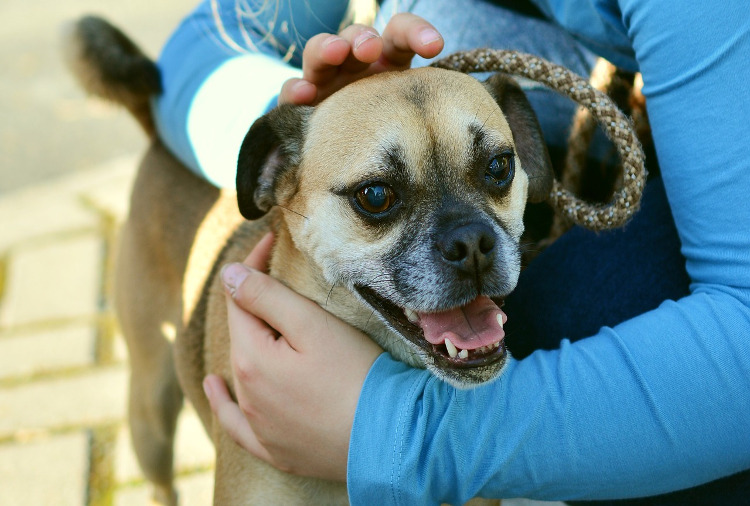![]()
Humans are not the only ones who may have dandruff; your pets can get it too. Dandruff is made up of dead skin cells, or dander, that fall from the skin. When clumped together, it looks like white flakes. Dandruff is most noticeable if your pet has a dark-coloured hair coat, or has been scratching or grooming themselves more often than is considered to be normal.
Causes of Dandruff in Pets
Allergies
Anything from dust mites and pollen allergies to certain food related allergy (especially protein sources) can cause a skin reaction in your pets. Allergies make a pet’s skin prone to dryness and itchiness. Superficial skin infections can be present as a secondary complication of allergies.
Skin infection from allergy can also look like dandruff to the untrained eye. Skin infection and itchiness can lead to further trauma to skin, thus causing even more dandruff to develop.
Hormones
Excess scaling can be caused by hormonal imbalances, such as a decrease in function of your pet’s thyroid gland (hypothyroidism), which is responsible for maintaining body temperature and metabolism. This imbalance will affect your pet to the point where their skin will look flaky. Hypothyroidism will usually also cause additional symptoms, other than dandruff.
Cheyletiella Mites
These skin mites are also known as “walking dandruff.” Making your pet’s life miserable by causing itchiness, these tiny, white parasites lay eggs in the skin and coat and feed on your pet’s dead skin cells. These mites are particularly problematic if regular flea preventatives are not used in your pet.
Low Humidity
If your home and/or the area you live is especially dry, the air might be stripping your pet’s skin of moisture, which causes frequent scratching and worsening of skin flakiness. Winter time, especially when the furnace or wood burning stove are on, is the most uncomfortable time for your pet.
Poor Diet
If your pet is not eating a nutritionally complete diet containing optimal levels of vitamins and minerals, the coat will become dull, coarse, and even crusty in some cases.
Food that is more expensive doesn’t necessarily mean it is better for you pet – it’s all about the right balance! Life-stage based feeding based on your pet’s age, life-style and nutritional needs is vital. This can be best determined by your family veterinarian.
Genetics
Golden retrievers, Jack Russell terriers, American bulldogs, and Norfolk terriers are a few breeds with known congenital causes of excess dandruff, a condition called ichthyosis. Also known as ‘fish-scale disease’, pets with this condition can’t help but make more dandruff. This is not a common condition and is best diagnosed by a qualified veterinarian or a vet dermatologist.
Dandruff Build-Up Prevention
In order to help keep your pet comfortable and to prevent secondary issues related to excessive dandruff and skin dryness, some simple recommendations can be followed. This will help your pet enjoy some extra one-on-one time with you, help them look their best, and help them stay comfortable.
Brushing:
Brushing your pets once a day will help distribute the natural oils from their skin through their hair coat. This will keep their coat feeling soft and looking shiny.
Improved Diet:
Make sure your pets are well hydrated. Consider giving your pet high-quality pet foods made by companies that invest in pet nutritional research. Foods that contain essential fatty acids also promote healthy skin and coat along with numerous other health benefits.
Specialized Topical Products:
There are shampoos, sprays, and mousses that are specially designed to re-moisturize pets’ skin, relieve the flakiness and improve the overall appearance of your pet’s hair coat. Consult with your veterinarian as they can make the best recommendation based on why your pet has dandruff in the first place. Do not use human anti-dandruff shampoos or conditioners as their ingredients may be too harsh to use on animals.
See the Vet:
If your pet is showing any additional symptoms in addition to dandruff, it is best to consult with a veterinarian while considering improved care as mentioned above. Itchiness, skin lesions, changes in body weight, changes in routine habits, gastrointestinal signs or any other concerns may be related to the dandruff. Your vet or pet dermatologist can properly diagnose the cause of your pets’ dandruff and give the right recommendations on treatments and prevention.
Creative Commons Attribution: Permission is granted to repost this article in its entirety with credit to VetDERM Clinic and a clickable link back to this page.



 by
by